G-BAM GAMES Camp Shows High School Girls What Mechanical Engineering is Like
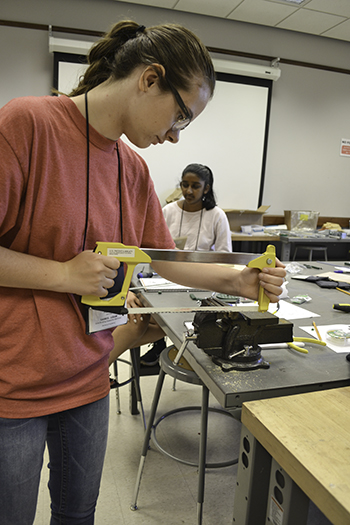
A G-BAM GAMES camper using a handsaw for the capstone project: Build Your Own Stereolithographic 3D printer.
October 4, 2017
On the cusp of making some important life decisions, like choosing where to go to college, what program to enroll in, and more importantly, what they want to do for the rest of their lives, 24 high school girls participated in G-BAM (Girls Building Awesome Machines) GAMES Camp might have had a few of their questions answered. Hosted by the Mechanical Science and Engineering Department (MechSE), the week-long engineering camp from June 18–24 exposed the girls to the kinds of things they might be doing should they choose a career in mechanical engineering.
According to MechSE Assistant Professor Elif Ertekin, co-director of G-BAM, along with MechSE Associate Professor Matt West and MechSE Educational Coordinator, Joe Muskin, all in their 5th year working with the camp, G-BAM’s goal was “to be able to show [the campers] very concretely what Mechanical Engineering is.”
And they did so via a variety of hands-on activities, tours, field trips, and a final project. Ertekin reports that the coordinators try to have a healthy mix of tried-and-true activities that they know are very effective, but also try to bring in a couple of new ones every year. So this year, they added a couple of new robotics activities. They also strive to have a nice mix of different types of activities, so interspersed with the many hands-on activities were tours and outings, such as the field trip to the Research Park to visit Caterpillar and a couple of startup, mechanical testing laboratories.
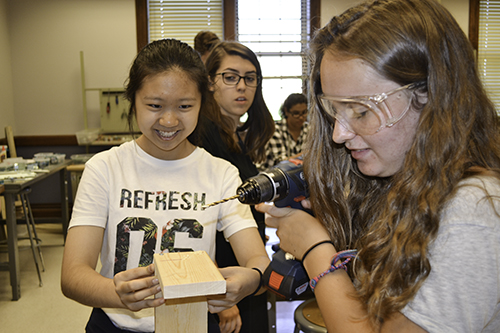
Two G-BAM campers putting together pieces for their project using a drill.
“Mechanical Engineering is such a broad discipline itself, and we want to try to give a sense of that to a lot of the students who are coming,” Ertekin explains.
For instance, in one activity, participants experienced what it’s like to work in a cleanroom; in another, they designed a prosthetic device, which, according to Ertekin, was not only a good example of how to use mechanical engineering and mechanical design to build prosthetics, but was “a very nice, concrete example of helping people and having an impact.”
Some activities were related to the final project they would build later on; for instance, they programmed Arduinos, and also learned how to use CAD (Computer-Aided Design), a computer application that allowed them to design a 3D object. And by the week’s end, they were able to print the object they’d designed on the 3D printer they were building.

Two G-BAM GAMES campers work together on their capstone project.
The capstone project of the camp was Build Your Own Stereolithographic 3D Printer. So over the course of the week, the girls did just that, actually designing and building a working 3D printer (a quite new technology), and were able to print the tiny 3D object they’d designed during another activity. One reason the 3D printer activity was a favorite with the camp directors is that it integrated so many different elements of engineering. For the mechanical design element, students had to build a moveable stage. For the electronics, students did the wiring and circuitry needed to control the motion of the 3-D printer’s stage. Students also learned some coding: they wrote small programs, which they controlled remotely, sending the signals wirelessly to the Arduino via their cell phones.
“They come up with really creative ideas for how to do this, Ertekin brags. “It's amazing.”
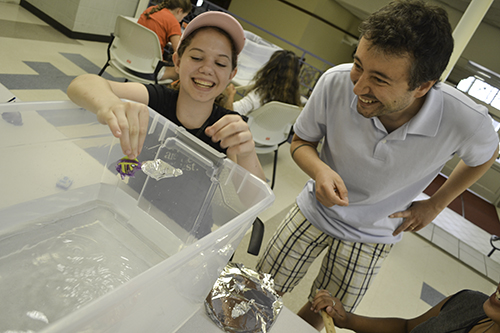
A G-BAM camper excitedly testing out her finished aquatic fish robot.
Another fun activity the campers did was Under the Sea: Aquatic Robotics, which involved navigating fish robots that were swimming around in pools. The activity was led by MechSE Assistant Professor Mattia Gazzola, whose research involves bio-propulsion in fluids. “So swimming and flying and things like that,” he explains.
Gazzola first taught the girls a few principles of biopropulsion: how a swimmer’s shape, body, and the material it’s made of impact its speed. Then the girls were given a fish robot and asked to modify its shape to see if it would swim faster by, say, attaching some foil to the fins. This initial activity was also designed to help the girls become more adept at maneuvering their robot fish because, for the pièce de résistance of the event, they would have to pilot their fish through an obstacle course—a baby swimming pool filled with 3D-printed obstacles strategically placed around the pool.

A fish robot made for the Under the Sea activity being tested underwater.
Are the fish robots part of Gazzola’s research? “Well, actually, you can buy them on Amazon,” he confesses. “These are very simple ones. I think they are like five dollars,” and explains that in his research, he mostly does simulations, “But these are still fun to play around with.”
Gazzola reported that his activity had gone great. While the girls had encountered some issues because there were only two radio channels, so sometimes one group’s remote was interfering with another’s, he says, “But now I think they found a stable configuration. They are doing well.”
The girls weren’t the only ones having a good time. “I'm having fun,” says Gazzola. “Actually I'd like to try one of these toys myself because I haven't yet. I should hi-jack one of them.”
Given that the GAMES participants are high school students, are the activities that are done during G-BAM a sort of watered down version of the kinds of things they do in their labs every day? Ertekin says no.
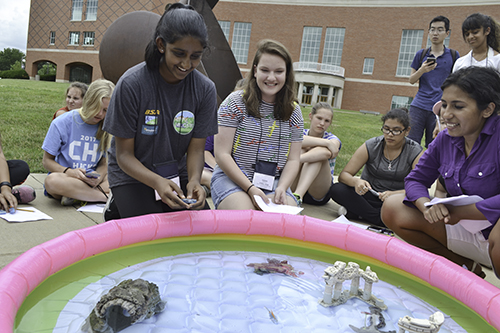
G-BAM Campers testing their fish robots outdoors on the Engineering Quad.
“What we show them is not too many steps removed from what we do in our research laboratories,” she explains. “And I think that's really important for them to see that what they're doing is really not that far away from the research world, because that really helps to demystify what it is that engineers do.”
Ertekin claims that the demystification of engineering aspect is key in recruiting students into engineering: “I think that's very important for them to be able to understand, 'Oh, this is accessible to me. It's not something that's out of reach; it's something that I can be a part of!’ And once you can visualize yourself doing something, you become much more likely to take that on, once it stops being so mysterious.”
She adds that a lot of the camp’s activities are designed to be able to accomplish this goal: “showing the students who come and spend time with us what it's like to be an engineering, giving them a real hands-on design activity, and then actually connecting that activity to research activity going on at the university, so they can see that what they're doing, it's not so watered down. It's actually very real.”
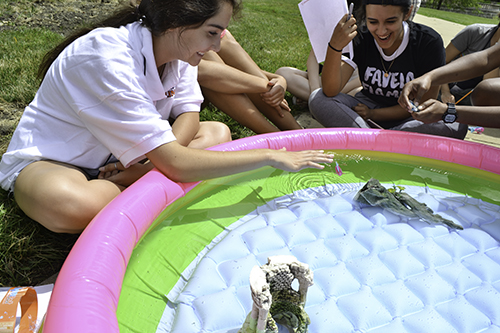
Fish robots being tested in a pool with different obstacles printed by the 3D printers campers made.
Why do Ertekin and other researchers who take part in the camp dedicate their time and energy to the outreach? Ertekin, for example, believes that it’s really valuable and important to bring high school students to spend time on campus and to show them what it’s like to be a student at Illinois studying Engineering.
“I think a lot of younger students have some idea of what engineering is,” she explains, “but being able to spend a week living here on campus, interacting with other students, undergraduate students, graduate students, and faculty, and working on engineering design projects really helps them to understand in a more concrete way what it is they would be doing as engineers. And I think that's really important and valuable for when they make their career decisions.”

A camper remote-controlling her fish robot while it swims through the obstacle course.
She further believes the impact of the camp to be “right at a time when a lot of attendees are starting to think about where to go to college and what program to enroll in, we are able to show them what it is that they would be doing if they choose to pursue an engineering career. And so I think the impact is really being able to kind of concretely show them, 'Hey, this is what you would be doing at this engineering setting studying engineering, and what kinds of options will open up to you once you get a degree in engineering.' So we're able to show them that, and hopefully motivate and encourage them to pursue this field by showing them how exciting, and dynamic, and creative it can be.”
She adds that Engineering is starting to track and actually see that most of the students who attended GAMES camps chose to pursue engineering careers, many of them at Illinois, “and we think that's wonderful,” she admits.
So what do she and the others involved with G-BAM get out of it?
“It's a lot of work,” Ertekin admits, “but it's really nice to be able to have this chance to remember what got me excited about engineering in the first place. It helps me keep my perspective and remember why it is I'm doing what I'm doing.”
She also finds it quite rewarding to see how “enthusiastic and creative and bright the upcoming generation of engineers is.” She likes being able to take a break from the busyness of her job, “to be able to dedicate a week to being able to work with a group of high school students who are so creative and energetic, and I just dedicate myself to that for that week, and it's refreshing, and it keeps my perspective broad.”
Story and photographs by Elizabeth Innes, Communications Specialist, I-STEM Education Initiative.
More: 8-12 Outreach, GAMES, G-BAM, MechSE, Summer Camp, Women in STEM, 2017
For additional I-STEM articles on 2017 engineering camps, please see:
- Campers Build Model Aircraft, Explore Possible Careers During Aerospace GAMES
- BioE GAMES Campers Are Exposed to Bioengineering, Engineering's Grand Challenges, & Encouraged to Stay in STEM
- High School Girls Discover Chemical & Biomolecular Engineering at GAMES Camp
- At ESE GAmes Camp High Schoolers Explore Career Options in Environmental & Sustainable Engineering
- GLAM GAMES Camp Helps High Schoolers Explore Materials Engineering Career Options













.jpg)
















